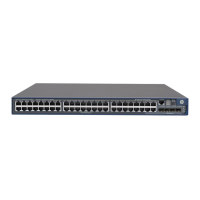90
View
HWTACACS scheme view
Default level
2: System level
Parameters
vpn-instance-name: Name of a VPN instance, a string of 1 to 31 case-sensitive characters.
Description
Use the vpn-instance command to specify a VPN instance for the HWTACACS scheme.
Use the undo vpn-instance command to remove the configuration.
The VPN specified here takes effect for all servers in the HWTACACS scheme for which no specific VPN
instance is specified.
Related commands: hwtacacs scheme and display hwtacacs scheme.
Examples
# Specify VPN instance test for HWTACACS scheme hwt1.
<Sysname> system-view
[Sysname] hwtacacs scheme hwt1
[Sysname-hwtacacs-hwt1] vpn-instance test
RADIUS server configuration commands
authorization-attribute (RADIUS-server user view)
Syntax
authorization-attribute { acl acl-number | vlan vlan-id } *
undo authorization-attribute { acl | vlan } *
View
RADIUS-server user view
Default level
2: System level
Parameters
acl acl-number: Specifies the number of an ACL in the range 2000 to 5999.
vlan vlan-id: Specifies the ID of a VLAN in the range 1 to 4094.
Description
Use the authorization-attribute command to specify the authorization attributes (ACL and VLAN) that the
RADIUS server will assign to the RADIUS client in a response message after the RADIUS user passes
RADIUS authentication. The RADIUS client uses the assigned authorization attributes to control the access
of the RADIUS user.
Use the undo authorization-attribute command to remove the configuration.
By default, no authorization attribute is configured.

